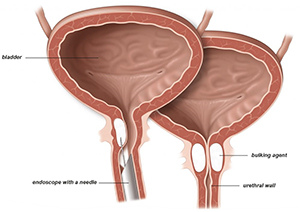
What is Urethral Bulking?
Urethral bulking is a procedure to treat a condition called stress urinary incontinence (SUI) usually in women.
Stress urinary incontinence is the involuntary loss of urine during activities that exert stress on the bladder, such as running, heavy lifting, hi-intensity exercises, coughing, laughing, and sneezing. It usually occurs when the muscles of the pelvic floor that support the urethra and the muscles of the urinary sphincter that control urination become weak. The condition is more common in women than in men and can be managed through treatment.
Urethral bulking procedure involves injecting a bulking agent into the walls of the urethra to make a watertight seal and prevent urine leakage from your bladder when you are involved in activities such as exercising, sneezing, or coughing. The aim of the procedure is to help patients obtain control over their urine flow. Urethral bulking has a success rate of about 70 percent in treating mild stress urinary incontinence. Common bulking agents include collagen (a type of protein found in body tissues) and water-based gels comprising various agents.
Indications for Urethral Bulking
Urethral bulking is usually indicated for the treatment of SUI in women:
- Who do not want to undergo surgery for SUI
- In whom traditional surgery has not been completely effective
- Who are not healthy enough for anesthesia and surgery
- Who wish to have have future pregnancies
- Whose SUI is mainly due to sphincter muscle deficiency surrounding the urethra
Urethral bulking may also be recommended in men with a mild degree of stress urinary incontinence as a result of prostate surgery.
Preparation for Urethral Bulking
Pre-procedure preparation for urethral bulking may involve the following steps:
- A thorough examination is performed by your doctor to check for any medical issues that need to be addressed prior to the procedure.
- Depending on your medical history, social history, and age, you may need to undergo tests such as urinalysis and blood work to help detect any abnormalities that could compromise the safety of the procedure.
- You will be asked if you have allergies to medications, anesthesia, or latex.
- You should inform your doctor of any medications or supplements that you are taking or any medical conditions you have such as lung or heart disease.
- You may need to refrain from certain medications such as blood thinners or anti-inflammatories for a week or two prior to the procedure.
- You should not consume any solids or liquids at least 6 hours prior to the procedure.
- Arrange for someone to drive you home after the procedure, as you may feel groggy due to the effects of anesthesia.
- A written consent will be obtained from you after the procedure has been explained in detail.
Procedure for Urethral Bulking
Urethral bulking is a same-day procedure and takes about 20 minutes to perform. In general, the procedure may involve the following steps:
- You will lie down on the procedure table in a supine position on your back.
- General or local anesthesia is administered to keep you comfortable throughout the procedure.
- You may also be given an antibiotic by mouth prior to the procedure to prevent any risk of infection.
- The genital area is thoroughly cleaned with an antiseptic solution and a local anesthetic jelly may be inserted into the urethra to lubricate and numb the urethral passage.
- A specially designed syringe or a cystoscope (a thin long instrument with an eyepiece on one end and a tiny lens and a light on the other end) is gently inserted into the urethra and slowly glided into the bladder. The small lens magnifies the inner lining of the urethra and bladder, allowing the doctor to clearly view any abnormalities.
- The bulking agent is then injected (often into 2 to 4 sites) via the syringe or the cystoscope around the walls of the urethra just under the neck of the bladder.
- The bulking agent makes the urethral walls narrow and thicker, which helps in better bladder control and less likelihood of leakage.
- Urethral bulking requires no cuts, incisions, or stitches in the abdomen or vagina.
Postoperative Care and Recovery
Post-procedure care and instructions may involve the following:
- You will be transferred to the recovery area where you will be asleep until the anesthesia wears off. Your nurse will monitor your vital signs as you recover.
- You will be discharged home on the same day of the procedure after your anesthesia wears off and you are able to pass urine normally.
- If you are unable to pass urine on your own, a catheter may be inserted to facilitate this until you can urinate normally.
- It is common for you to feel soreness or pain in the urethra due to the instrument passed. You will be given pain and anti-inflammatory medicines to address this.
- Your physician may also prescribe medications to address symptoms associated with anesthesia and antibiotics to prevent risk of infection.
- It is normal for you to feel the need to urinate more frequently for the first few days after the procedure.
- You may notice blood in the urine and a burning or stinging sensation upon urination. Appropriate medicines are prescribed to address this.
- Applying a warm or damp cloth over the genitals is also recommended to address the discomfort.
- You should be able to resume your normal activity within a few days unless your physician instructs otherwise.
- A follow-up appointment will be scheduled to monitor your progress.
Risks and Complications
Urethral bulking is a relatively safe procedure; however, as with any surgical procedure, some risks and complications may occur, such as:
- Bleeding
- Infection
- Pain at the injection site
- Injury to the urethra
- Burning or pain on urination
- Adverse reactions to anesthesia
- Migration of the bulking agent
- Need for a repeat procedure
